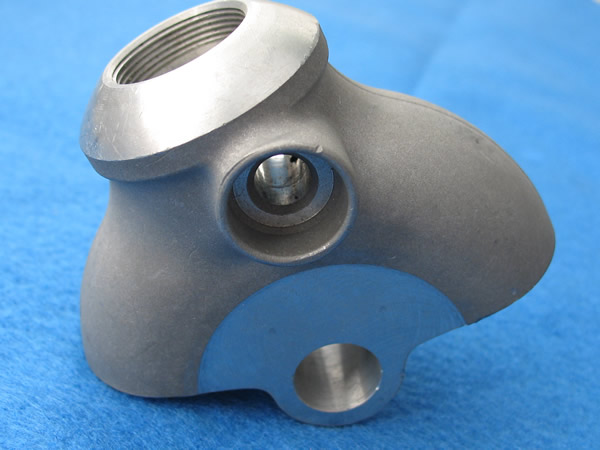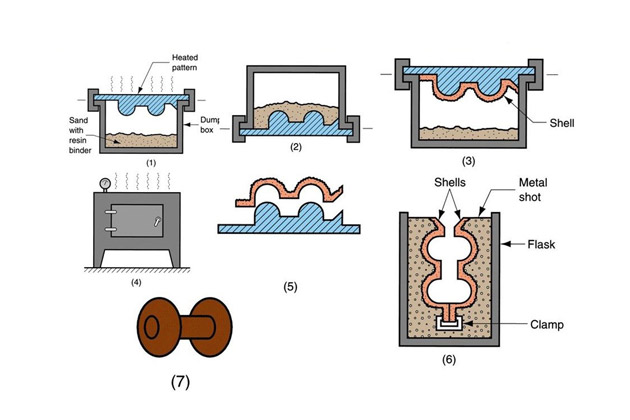Aluminum Casting and sustainability: Green benefits of recycling
Wiki Article
A Comprehensive Overview to the Different Kinds and Applications of Aluminum Castings
Aluminum castings are important elements in different markets, understood for their light-weight and resilient homes. Different casting approaches, such as sand, die, and financial investment casting, offer distinctive advantages tailored to specific applications. Recognizing these processes is essential for picking the right technique for a task. Each technique has its special benefits, affecting style and production options. The expedition of these approaches reveals a deeper understanding into their impact on modern-day production.Overview of Aluminum Castings
Aluminum castings are crucial parts in various markets, understood for their lightweight and corrosion-resistant residential or commercial properties. These castings are created with processes that enable detailed styles and high dimensional accuracy. The convenience of aluminum makes it an optimal selection for a variety of applications, from auto components to customer electronic devices. Because of its outstanding thermal and electric conductivity, aluminum is likewise preferred in electric real estates and warmth sinks. Aluminum castings can be treated with different surface area coatings, boosting their visual appeal and toughness. The material's recyclability includes to its sustainability qualifications, making it an environmentally pleasant alternative. Furthermore, the schedule of various aluminum alloys allows makers to tailor the mechanical residential properties to specific requirements, supplying boosted strength or boosted resistance to use. Generally, aluminum castings play a significant function in contemporary production, adding to the efficiency and performance of numerous items across varied fields.Sand Casting: Refine and Applications
While numerous casting techniques exist, sand casting stays among one of the most extensively used strategies because of its simplicity and adaptability. This procedure involves developing a mold and mildew from a mix of sand and a binding representative, enabling the manufacturing of complex shapes with high dimensional accuracy. The aluminum is melted and put right into the mold, where it takes the preferred kind as it cools down and strengthens.Sand casting is specifically efficient for generating large components and low to tool volume runs, making it appropriate for various sectors, including vehicle, aerospace, and durable goods. Its adaptability enables the casting of detailed layouts, fitting varied specs. Additionally, sand molds can be recycled several times, enhancing cost-effectiveness. The ease of sourcing materials and the relatively reduced configuration costs additionally add to its prevalent adoption. On the whole, sand casting plays a critical duty in the aluminum casting landscape, cultivating innovation and effectiveness.
Die Casting: Benefits and Utilizes
Die casting offers several benefits that make it a recommended method for creating aluminum elements in different industries. This process permits for high-volume production with outstanding dimensional precision and surface area finish. The quick solidification of aluminum during die casting leads to a solid and sturdy item, lessening the demand for considerable machining or ending up procedures.Furthermore, die casting makes it possible for the manufacturing of intricate shapes and complex designs, which can be challenging to attain with various other casting approaches. The effective usage of materials reduces waste, making it a cost-efficient option for manufacturers.
Applications of die casting span different sectors, including automotive, aerospace, and consumer electronic devices, where lightweight and high-strength parts are crucial. In general, pass away casting attracts attention for its capacity to provide top quality, performance, and versatility in aluminum element manufacturing, solidifying its function in contemporary manufacturing methods.
Financial Investment Casting: Precision and Information
Financial investment casting is a precision production procedure that permits elaborate layouts and thorough features in aluminum components (Aluminum Casting). This technique supplies numerous benefits, including high dimensional precision and a smooth surface coating. Its versatility makes it relevant across different markets, from aerospace to clinical devicesProcess Introduction
The financial investment casting process stands out for its capacity to generate complex aluminum components with remarkable precision and detail. This method starts with developing a wax or polymer pattern that is a reproduction of the preferred part. Next off, the pattern is coated with a ceramic covering, which is after that heated up to harden. When the covering is established, the wax is melted away, leaving a cavity in the covering. Liquid aluminum is put right into this dental caries, loading it to create the last component. After cooling down, the ceramic shell is broken away, revealing the cast part. This procedure permits for intricate geometries and fine surface area coatings, making it ideal for various applications, from aerospace to automotive industries.Benefits of Financial Investment Casting
Among the key advantages of financial investment casting hinges on its ability to supply high-precision elements with detailed information. This method permits the creation of complex geometries that are typically unattainable with various other casting strategies. Investment casting minimizes the need for considerable machining, decreasing material waste and manufacturing time. Additionally, it makes it possible for making use of various aluminum alloys, improving the adaptability of the last product. The procedure is identified by a smooth surface coating, which can result in enhanced capability and appearances. Furthermore, financial investment casting is fit for both tiny and huge production runs, suiting a vast range of markets. Generally, its precision and effectiveness make investment casting a recommended selection for producing components calling for specific specifications.Applications in Sector
While numerous casting approaches offer particular objectives, financial investment casting stands out for its extensive applications across numerous industries because of its unparalleled accuracy and detail. This strategy is specifically preferred in aerospace and vehicle sectors, where complex elements call for specific requirements for safety and security and performance. Investment casting enables the manufacturing of complex shapes, such as turbine blades and engine parts, that typical approaches can not achieve. Furthermore, medical gadget makers utilize financial investment casting for producing highly detailed instruments and implants, guaranteeing biocompatibility and performance. The electrical and electronics markets likewise benefit, producing parts like housings and adapters that require fine tolerances. Generally, financial investment casting's flexibility and accuracy make it an important procedure in contemporary manufacturing throughout diverse areas.Contrast of Casting Approaches

Sand Casting Advantages
Sand casting uses numerous benefits over various other casting techniques, especially when it concerns flexibility and cost-effectiveness. This technique permits the production of intricate shapes and big components without the need for pricey tooling. Furthermore, the sand made use of in this process is readily offered and affordable, making it an attractive alternative for both tiny and big production runs. The capability to reuse sand promotes sustainability and minimizes material costs. Sand casting suits a selection of aluminum alloys, enhancing its versatility for various applications. The procedure is also relatively simple, which contributes to much shorter preparations and adaptability in production. These aspects make sand casting a preferred option for many industries looking for reputable and economical services.Die Casting Efficiency
Although numerous casting techniques are available, die casting attracts attention for its performance, specifically in high-volume production scenarios. This technique utilizes high-pressure forces to inject molten aluminum right into a mold, causing quick cycle times and consistent item top quality. Compared to sand casting and financial investment casting, pass away casting considerably reduces product waste and allows for complex layouts with limited tolerances. The capacity to generate big amounts of parts rapidly makes it suitable for industries such as automobile and durable goods. On top of that, die casting can facilitate the usage of less expensive alloys, further boosting its cost-effectiveness. Overall, the performance of die casting makes it a recommended selection for makers intending to enhance both production rate and quality.Financial Investment Casting Precision
Financial investment casting is commonly identified for its phenomenal accuracy in generating complicated shapes and complex information. This approach entails developing a wax pattern, which is covered in a ceramic shell, and ultimately thawed away, leaving an accurate tooth cavity for molten aluminum. Compared to other casting techniques, such as sand casting or die casting, financial investment casting supplies tighter tolerances and a smoother surface area finish. This accuracy makes it ideal for applications calling for high accuracy, such as aerospace and medical gadget components. While the initial setup costs might be higher, the long-term advantages consist of lowered machining needs and regular high quality. As a result, investment casting stands out as a preferred selection for elaborate styles and requiring specifications in different industries.Market Applications of Aluminum Castings
Aluminum castings play a vital duty throughout various markets because of their light-weight, corrosion-resistant residential or commercial properties and exceptional strength-to-weight proportion. In the auto field, aluminum castings are thoroughly used for engine elements, transmission real estates, and structural parts, adding to sustain performance and performance. The aerospace market take advantage of aluminum castings in aircraft frameworks, engine installs, and indoor installations, where weight decrease is crucial.On top of that, the consumer electronic devices market uses aluminum castings for rooms and parts, boosting toughness while keeping a streamlined aesthetic. In the building industry, aluminum castings are used in architectural components, home window frames, and architectural assistances, giving resilience against weathering. Moreover, the aquatic industry favors aluminum castings for watercraft hulls and installations because of their resistance to saltwater deterioration. Overall, aluminum castings supply flexible solutions, satisfying varied needs throughout numerous applications while keeping high efficiency and reliability.

Future Patterns in Aluminum Casting Modern Technology
As sectors continue to advance, innovations in aluminum casting technology are positioned to improve making processes and product style. Emerging trends consist of the assimilation of automation and synthetic intelligence, simplifying manufacturing and improving quality assurance. 3D printing is also gaining traction, enabling extra complex geometries and minimized waste, thereby advertising sustainability. In addition, the growth of high-performance alloys is expanding the applications of aluminum castings, enabling industries to meet extensive performance criteria.One more considerable pattern is the boosting focus on recycling and the round economic climate, with advancements targeted at reusing aluminum scrap effectively. Industry players are additionally investing in wise production strategies, integrating IoT for real-time surveillance and predictive upkeep. Finally, advancements in surface treatment innovations are boosting the resilience and visual charm of aluminum castings. Collectively, these trends signify a transformative period in aluminum casting, driving efficiency, sustainability, and advancement across various markets.
Frequently Asked Inquiries
What Are the Environmental Impacts of Aluminum Casting Processes?
The environmental influences of aluminum casting procedures include greenhouse gas emissions, energy consumption, and waste generation. These aspects add to air and water contamination, triggering the need for lasting techniques and improved resource management in the market.How Can Aluminum Castings Be Recycled Properly?
Reliable recycling of aluminum castings involves collecting scrap, getting rid of contaminants, and thawing the aluminum to create brand-new castings. This process preserves power, minimizes waste, and decreases environmental impacts, advertising a more lasting production cycle.What Is the Normal Life Expectancy of Aluminum Castings?
The common life-span of aluminum castings differs significantly, commonly long lasting between 20 to 50 years depending upon ecological aspects, alloy make-up, and application. Their resilience makes them ideal for various requiring commercial and structural usages.Exist Any Type Of Wellness Dangers Associated With Aluminum Casting?
Worries regarding health and wellness risks connected with aluminum casting include potential direct exposure to fumes and dust. Extended breathing may cause respiratory issues, while skin call can trigger irritability. Proper precaution are necessary to minimize these dangers.Just How Do Aluminum Castings Compare to Other Products in Toughness?
Aluminum castings display a favorable strength-to-weight ratio contrasted to lots of materials, including steel and plastics (Aluminum Aluminum Casting Casting). They are lightweight yet strong, making them optimal for applications requiring sturdiness without extreme weight, such as automotive and aerospace componentsReport this wiki page